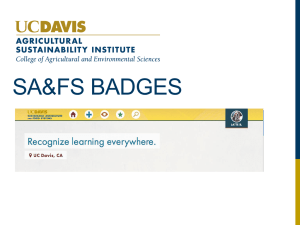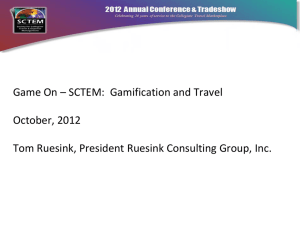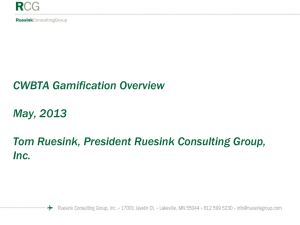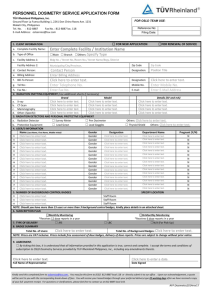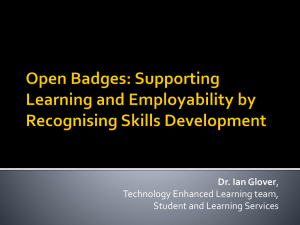Gamification Overview PPT
advertisement
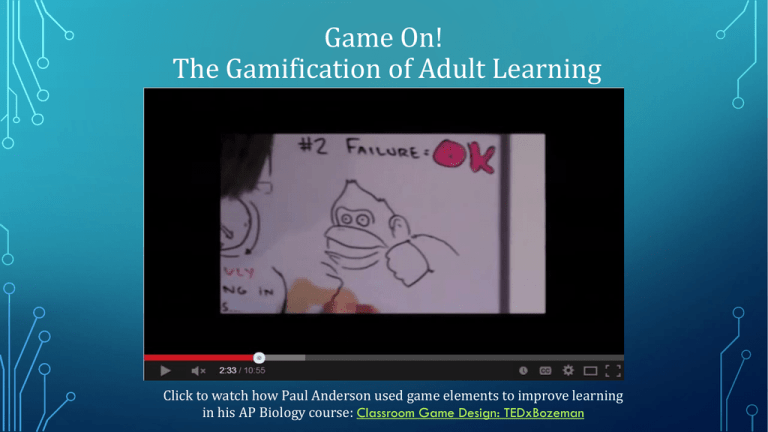
Game On! The Gamification of Adult Learning Click to watch how Paul Anderson used game elements to improve learning in his AP Biology course: Classroom Game Design: TEDxBozeman What is Gamification? Gamification is the application of game mechanics and psychology to drive desired behaviors in nongame settings. Source: (Trees, 2013). What are common game elements? Rewards • Badges • Privileges Self-expression • Avatars • Choice Status • Titles Competition • Leaderboard Achievement • Levels • Points/grades Emotion What is a badge? A badge is a visual validation of achievement that indicates a person’s knowledge, skill, or accomplishment. Think of badges as a way to recognize a person’s multifaceted abilities. Badges allow students to provide a more comprehensive developmental narrative to share with peers, parents, teachers, and potential schools or employers. Source: (,) What are some achievements that can be rewarded with badges? • Performance • Product • Behavior • Attendance • Punctuality • Respect • participation Why use badges? • To signify successes, establish goals, and foster positive learning and working habits • Completing projects and performances • Mastering concepts • Rewarding behavior • • • • • Attendance Punctuality Leadership Respect Participation How do I deliver badges? • Identify learning goals and reward progress and completion. • Identify behaviors and reward demonstration (e.g. artifact creation, skill development, participation, goal achievement, reflection) and how you can recognize multiple aspects of learning. • Identify competencies. Points • Rewards • Status (leaderboard) • Achievement • Competition • digital games (1) are built on sound learning • principles, (2) provide more engagement for the learner, (3) provide personalized learning • opportunities, (4) teach 21st • century skills, and (5) provide an environment for authentic and • relevant assessment.best Leaderboards • COmpetitit What behaviors do gamers exhibit? • Risk taking (freedom to fail) • Persistance • Attention to detail • Problem-solving skills What characteristics of gaming benefit learning? • Enables individual pacing (personalized learning) • Fosters collaboration • Fosters “just in time learning” earning • Fosters active construction of learning What learning tools are embedded in games? • Structure • Goals • Feedback • Path to progress (Trees. 2009, p. 16) What does the research say? • Navigation, military training and health care games and simulations have been widely used with a certain degree of success • Gameplay constitutes a particularly effective way of organizing learning activities • Gameplay is regarded as an important arena for the development and formation of thinking, identities, values and norms Sources: (Gee, 2003); (Rystedt, 2002); (Cole, 1996; Piaget, 1951; Rogoff, 1990) What are the barriers to adoption? • Schools slow to adopt new innovations • Research around play patterns and learning was limited • Designing good games was difficult • Parent and educator attitudes toward games • Lack of PD for teachers to integrate gaming • Skills that games develop are not assessed in standardized tests • Lack of evidence to support use (MLGF p20) Resources GamificationCorp. Jane McGonigal, TedTalk: Gaming can make a better world Seth Priesbatch, TedTalk: The game layer on top of the world Mozilla Open Source Badges References Deterding, S., Dixon, D., Khaled, R., Nacke, L. (2011). From game design elements to gamefulness: Defining “gamifcation.” Proceedings of the 15th International Academic MindTrek Conference: Envisioning Future Media Environments (MindTrek ’11). New York, NY. Klopfer, E., Osterweil, S., & Salen, K. (2009). Moving learning games forward: Obstacles, opportunities, and openness. The Education Arcade: Massachusetts Institute of Technology. Retrieved from http://www.educationarcade.org/ Trees, L. (2013). Gamification in knowledge management: How it works and what your organization should know. Houston, TX: APQC white paper.


